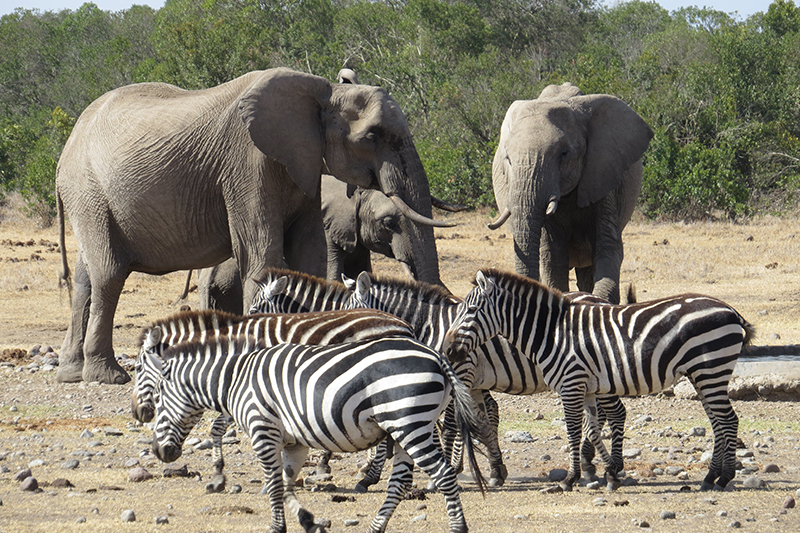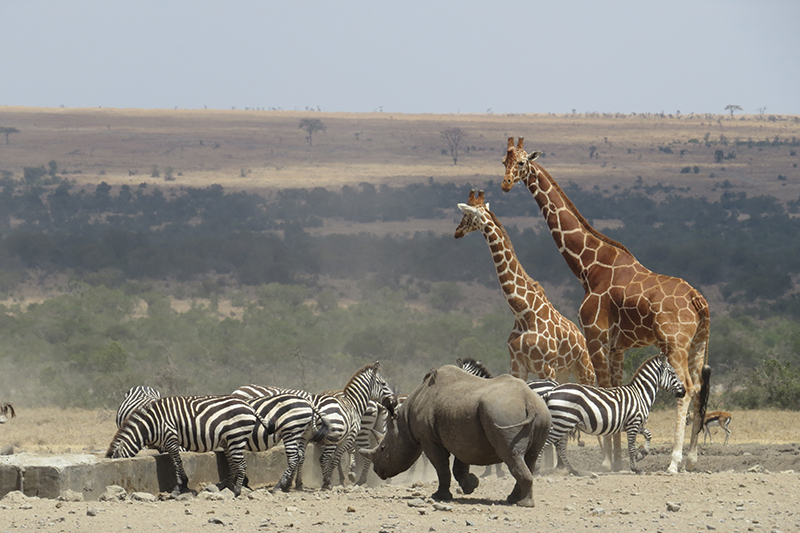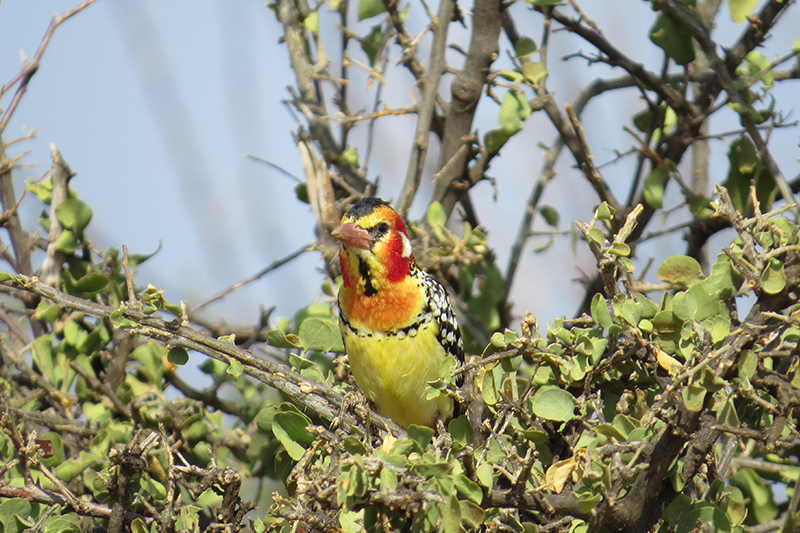It’s always a treat to make a return to Kenya – there’s something about the people, the warm smiles, the familiar faces that makes it such a special country to visit. In March 2023, I headed out to the Laikipia region to spend seven nights visiting some new properties and some old favourites.
I took the daylight Kenya Airways flight out to Nairobi, part of their extended schedule meeting the current high demand for flights to Nairobi, which meant I arrived in the evening. I decided to spend the night at Ololo Lodge in Nairobi National Park. While I wouldn’t particularly recommend it for a quick overnight stay, it does have a lovely feel to it, away from the hustle and bustle of the city. However, it is not exactly sheltered away from the flight path to the airport. If you can get over that, it really is a charming little lodge, with a functioning farm which you can take a look around. On the transfer to Wilson Airport through the National Park the next morning, it was part game drive, as we drove past buffalo, rhino, zebra, lion, impala, giraffe and eland – which is always a nice start to the trip!



The first thing that struck me as I flew from Wilson Airport up to the Mugie Conservancy, north of Nanyuki, was just how dry the region really was. I had been aware of the drought, and heard how dry things are, but it’s hard to comprehend the extent of it until you see it firsthand.
I began my trip in the Mugie Conservancy, staying at the lovely Ekorian’s Mugie. The camp is charming, with beautiful spacious tents and really friendly staff. It has a nice feel to it, especially suited to families with kids, with board games, an archery target, spear throwing, a trampoline, and a small swimming pool to keep little ones busy in camp. On the conservancy, in addition to game drives, bush walks and night drives, you can enjoy camel rides, fly camping, and kayaking on the dam. There is a very sociable giraffe called Tala located at the Mugie Conservancy Headquarters who always appreciates a visit. We didn’t see another vehicle during my whole stay, which is a rare experience these days, but we did see lots of beautiful Grevy’s zebra, and a striped hyena.



From Mugie, I travelled south to the El Karama Conservancy. The warm welcome here was wonderful. There is an array of different room types at the lodge, several to accommodate families of different ages. The Hobbit House is ideal for smaller kids, or families who want to be in one unit; while the bandas work well for couples or families with older children. I was lucky enough to stay in the newly built (2022) Nilotica Private House, which operates with its own private main area and private vehicle. A great addition for families is the delightful “bush school” which keeps kids busy after the morning activity. The food was excellent and the conservancy itself is beautiful. We were fortunate to find a pair of mating lions on our evening game drive, and we enjoyed a wonderful bush walk the next morning as the sun rose with a clear view of Mt Kenya as the backdrop.



I then spent a night on the Ol Pejeta Conservancy. I had been to Ol Pejeta in March 2020 when they had had good rainfall, and everything was lush, green and bountiful. Three years later, and some parts of the conservancy felt similar to the salt pans of Etosha National Park. As soon as we drove on to Ol Pejeta Conservancy, the game viewing was noticeably more prolific. The drought meant that all the pumped waterholes or troughs were absolutely teeming with wildlife – elephants, rhino, zebra, impala and giraffe all gathered round in one place. The conservancy is admittedly not the wildest game viewing location in Africa as it is quite heavily managed, but you really cannot take away the fact that the game viewing experience is excellent. The rhino viewing is superb, but we also had some great elephant sightings, as well as buffalo and I enjoyed my gin and tonic sundowner next to some sleepy lionesses and less sleepy lion cubs.



Following Ol Pejeta, I moved onto the Lewa Wildlife Conservancy, which definitely has a more scenic and expansive landscape. My guide Godfrey and I watched as a group of five bull elephants broke down the fence of a protected area of the conservancy. Godfrey said this happened like clockwork most afternoons at the same time, as this group of naughty bull elephants had learned what time the conservancy staff would head home. It was amusing to watch, but also a reminder of the limited grazing the wildlife had access to when conditions were so dry. I spent two nights on the Conservancy, and we had some great game viewing, especially around the very picturesque swamp. I also had some incredible meals out in the bush: a bush breakfast with Elewana and sundowners with Lewa House, both with spectacular views.
My final stop in Kenya was Sarara in the Namunyak Wildlife Conservancy – a truly magnificent place north of Samburu National Reserve. I stayed at both Sarara Treehouses and Sarara Camp. The conservancy is genuinely breath-taking; just under a million acres in size and flanked by the Mathews Range mountains making for dramatic scenery in every direction.



While the game around the camps was active, with elephants, buffalo, giraffe and zebra constantly present, the Samburu culture is the real reason to come here. My guide and tracker were local Samburu (as are all the staff at Sarara) and we had so much fun learning about each other’s cultures. They had a really cheeky sense of humour which made everything so enjoyable.
I managed to fit a lot in during my two nights in the area. I visited the singing wells, an ancient Samburu tradition, which is something so special to experience. The Samburu bring their livestock to drink from the dry riverbed, and as they dig for water in the wells, they sing. Each family has their own trance-like chant, and the camels, goats and cattle know which well to drink from based on the song being sung. The Samburu believe that having a photo taken is like taking some of their soul, so no cameras are allowed, which makes it an even more unique experience in this modern world, where everyone tries to capture everything on film.



I was also lucky enough to visit the Reteti Elephant Sanctuary (also run by the local community) located on the conservancy. We visited at midday, when the tiny young ones enjoy a mudbath, and I can’t even describe how joyful it is to witness these funny little characters making the most of the mud in the midday heat. The naughty ones were trying to escape, the lazy ones were wallowing in the mud, the cheeky ones were playing with the hosepipe! We also watched as they all got their midday milk, and again the Samburu chanted as the elephants came out to drink, which gives you goosebumps, as you witness the relationships between the keepers and the elephants.
Walking is a highlight at Sarara, more so than game drives. It’s possible to do as much or as little as you like, you can enjoy gentle walks around camp, but also extensive hiking up into the Mathews Range.



There is so much more to do at Sarara than I had time for. You can visit a local manyatta, learn about the mobile Montessori school and healthcare programme, you can practice beading with the local Samburu ladies or blacksmithing with the local ironmongers, enjoy night drives, birding, horse riding, endless walking and hiking opportunities, as well as fly camping under the night sky. I just couldn’t fit everything in during my two nights unfortunately, but I came away knowing how special a place Sarara is, and I’ll remember my stay there for a very long time.
Frances stayed at Ololo Lodge, Ekorian’s Mugie, El Karama, Ol Pejeta Bush Camp, Elewana Kifaru House, Lewa House, Sarara Treehouses, Sarara Camp.
Frances visited Elewana Lodo Springs, Governors Mugie House, Sosian, Laikipia Wilderness, Kicheche Laikipia, Sanctuary Tambarare, Ol Pejeta Safari Cottages, Elewana Lewa Safari Camp, Sirikoi, Lewa Wilderness, Reteti House, Fairview, Palacina, Hemingways Nairobi, Hemingways Eden, Manzili House and House of Waine.

